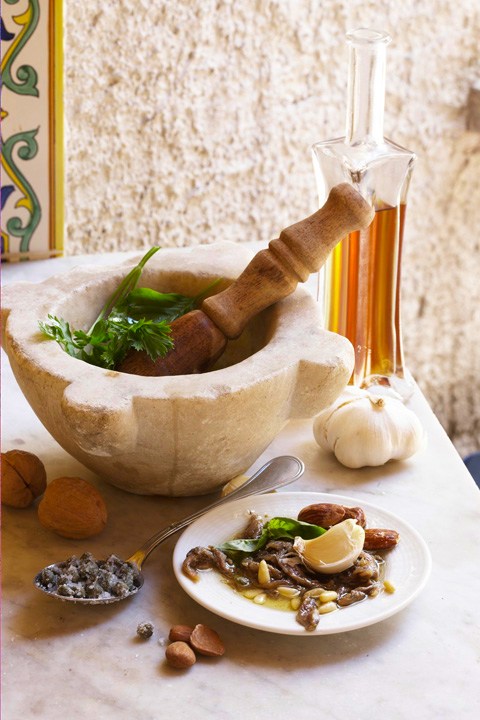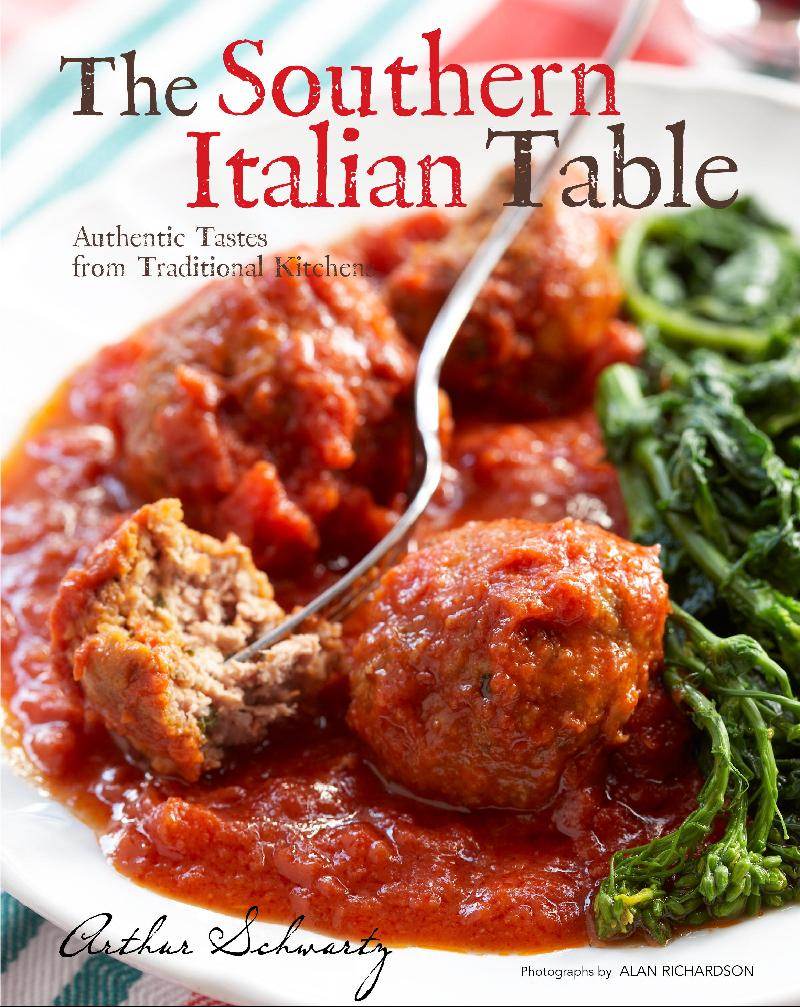Pesto Persuasion from Arthur Schwartz
"It's still hot as hell outside, and who wants to cook anyway," my friend Arthur Schwartz emailed this week, offering recipes for a handful of variations. Use them on pasta of course, or on toast -- bruschetta -- on boiled potatoes or as a dip for crudités. Pesto may be stored in the refrigerator for up to a week but is best on the day it is made.
PESTO TRAPANESE/TRAPANI PESTO
Makes 3 cups, enough to sauce 1 1/2 to 2 pounds of pasta
Sicily has nothing if not almond trees, which is why the island's cuisine uses them in everything from antipasto to dessert.
6 ounces blanched almonds (1 1/3 cups)
3 large cloves garlic, peeled
2 cups firmly packed fresh whole basil leaves
1 teaspoon salt, or more to taste
1 pound very ripe tomatoes (can be cherry tomatoes), washed
1/4 cup extra-virgin olive oil
In a food processor fitted with the metal blade, combine the almonds and garlic. Process until very finely chopped, almost a paste.
Add the basil and salt. Process again until the basil is very finely chopped.
Add tomatoes and oil and process one more time until the mixture is a fine paste. Taste for seasoning and add more salt if necessary.
Use to sauce 1 1/2 to 2 pounds of spaghetti, linguine, or tubular pasta such as penne or ziti. Also good on grilled lamb, steak, or chicken. If serving with lamb, you may want to substitute some mint for part of the basil.
PESTO DI CAPERI/CAPER PESTO
Makes about 1 cup
In places where they commercially grow most of the world's best capers, it's only natural that they would use these precious pearls of the field in some prolific manner. On Salina and Lipari, the two big islands of the Aeolian archipelago between northern Sicily and Calabria, and on  Pantellaria, the Sicilian island near Tunisia, they make a pesto like this and it's sold in jars to the tourists.
Pantellaria, the Sicilian island near Tunisia, they make a pesto like this and it's sold in jars to the tourists.
Capers being as expensive as they are, this is nearly as luxurious as caviar, but saltier. It's salt content makes it perfect to spread on bland crackers, bruschetta or crostini to go with drinks, or to toss on pasta, or to spread on a sandwich of, say, tomatoes and mozzarella. Or to dab on top of a cross-cut cherry tomato for a cocktail party. It's also great on fish, and as a vegetable dip-raw on red, orange, and/or yellow pepper strips are particularly good. On Lipari, I even ate cold sliced tongue dressed with a caper pesto like this, making me feel it's an excellent topper, too, for a carpaccio of tuna, or raw roast beef.
4 ounces (2/3 cup) salted capers, rinsed well
2 anchovy fillets
2 cloves garlic
1/2 cup loosely packed parsley
1 teaspoon dried oregano
1/2 teaspoon crushed red pepper
1 tablespoon white or red wine vinegar
1/2 cup extra-virgin olive oil
In a mortar with a pestle, pound together the capers, anchovies, garlic, parsley, oregano, and hot pepper. When the ingredients have formed a coarse paste, add the vinegar.
Keep working the pesto with the pestle, then add the oil and continue grinding and pounding until the pesto is relatively smooth, or you get tired, whichever comes first.
The pesto can be served immediately, but it is better after it sits at room temperature for a few hours. It can be stored for several weeks in a tightly closed jar in the refrigerator.
PESTO CETARESE/PESTO FROM CETARA
In Cetara, a small fishing town at the top of the Amalfi Coast, pesto is made with the salt-preserved anchovies the town is famous for, and with colatura, the town's most esoteric product -- a liquid essence of anchovy "expressed" by the fish when they are preserved in layers of sea salt. Add to the anchovies some walnuts - the fat and flavorful Sorrento walnuts from the peninsula are famous-- pine nuts, fresh basil and parsley, and salt-preserved capers, another regional favorite food.
1 rounded tablespoon pine nuts
1 rounded tablespoon walnuts
1 tablespoon almonds
1 large clove garlic
4 loosely packed cups basil, well-washed and dried
1 loosely packed cup parsley, well-washed and dried
3 tablespoons condiment quality extra-virgin olive oil
1 3.5-ounce can or jar of anchovies, drained of oil or 8 to 10 salted anchovies, filleted and rinsed
2 rounded tablespoons salted capers, rinsed and soaked a few minutes in cold water, and drained
Colatura (optional)
In a mini-processor, finely chop the pine nuts, walnuts, and almonds with the garlic. Add half the basil. Process until finely chopped. Add the remaining basil, the parsley, and the olive oil. Process again briefly. Stir up from the bottom, then process again until all the herbs are a fine paste. Add the anchovies and capers. Process again, until homogeneous.
Season with colatura, if desired.
MATAROCCO GARLIC PESTO FROM MARSALA
Makes about 1 1/4 cups enough for 1 lb. of spaghetti, linguine, or any macaroni
When I get to a city, town or village, it's my fun to search for the dish that locals love but that hardly anyone outside that city, town or village knows about. There usually is one. In Marsala, on the west coast of Sicily, the same  local dish was cited by everyone I asked: Matarocco.
local dish was cited by everyone I asked: Matarocco.
Matarocco is a small town just outside Marsala, and the same sauce in some Sicilian cookbooks is also called pesto Siciliano, or pesto alla Favignana.
Whatever the name, there are two ways to combine the ingredients. The old way is to pound everything together in a mortar with a pestle, in which case the sauce is a true pesto. It isn't a pretty pesto. Even with tomatoes, it turns out beige. But what it loses in looks it gains in a creamy quality that the other form of Matarocco lacks. If you don't enjoy pounding, you can make a reasonable version in a mini-processor. Either way, Matarocco is always made in the morning and allowed to sit at least until midday, to mellow and cure.
3 small heads spring garlic, or 2 small heads mature garlic, each clove peeled
1 loosely packed cup basil
1/2 loosely packed cup parsley
A few celery leaves, if available
1/4 cup pine nuts
3/4 teaspoon salt
1/4 teaspoon crushed red pepper or a rounded 1/4 teaspoon freshly ground black pepper
1/2 pound round tomatoes, peeled, seeded, and juiced
6 tablespoons extra-virgin olive oil
Combine all the ingredients, except the olive oil, in a large mortar. Grind and crush the ingredients until you have a rough sauce.
Alternately, put all the ingredients into a mini-processor and grind to a loose paste.
Add the olive oil and continue to work the ingredients, whether in a mortar or processor, to make them finer, the pesto creamier.
Let stand for at least 3 hours before using.
To read more of Arthur "Arturo" Schwartz musings and recipes, click here. And to buy "The Southern Italian Table" cookbook right now at Amazon, click here.